Damage Mechanism Evaluation of Large-Scale Concrete Structures Affected by Alkali-Silica Reaction Using Acoustic Emission
Abstract
:1. Introduction
2. Materials and Test Setup
2.1. Specimen and Chamber Preparation
2.2. Measurement Equipment
3. Analysis Method
3.1. Pattern Recognition Algorithm
4. Results and Discussions
4.1. Acoustic Emission Energy Release
4.2. Pattern Recognition of AE Data
5. Conclusions
- A significant portion of the AE data (in terms of cumulative signal strength) in the confined specimen was recorded by sensor 3, which was located at mid-thickness. However, the portion of cumulative signal strength for the corresponding sensor at mid-thickness of the unconfined specimen was less in comparison to the other two sensors in that specimen. This agrees with expectations, as the confined specimen exhibited increased out-of-plane expansion in comparison to the unconfined specimen, meaning that the crack distribution is expected to be more concentrated near mid-thickness of the confined specimen than near the reinforcement layers.
- The frequency contents of signals in the confined and unconfined specimens evolved from low to high frequency with the age of concrete although this evolution started later in the confined specimen than the unconfined specimen. Since the high-frequency AE signals have been associated to the cracking in aggregates [17], different crack mechanisms in aggregate for the confined and unconfined specimens are expectable. However, there are different contradictory ASR cracking hypotheses that have been proposed by the researchers [33,34,35,36,37,38,41,42,43].
- There is a coincident point observed in the strain curves and the CSS of Cluster-3 in the confined specimen and Cluster-6 in the unconfined specimen. The CSS rate in terms of concrete age increases at the time (around 150 days), when the strain rate is decreasing. This point is named as inflection point of strain curve, where the curvature of strain curve changes from positive to negative. The inflection point location in terms of concrete age depends on the kinetic of ASR reaction and diffusion process. Determining the inflection point, latency and characteristic time are experimentally estimated, which are the two important modeling parameters. According to the results of AE data and clustering, the inflection point location in terms of concrete age could be estimated from the variation in CSS rate change of clustered AE data.
- Monitoring of a structural system with acoustic emission can provide useful information regarding condition based maintenance and/or retrofit. For example, one potential time of action for treating affected structures is around the inflection point in the volumetric strain curve which can be approximated through acoustic emission data. This point coincided with observation of first visible surface cracking. After identifying the time of action, treatment methods may be implemented to mitigate the effects of ASR. Injection of lithium solution is a chemical alternative to mitigate ASR provided that enough solution penetration in the structure can be achieved. Another method is to remove moisture through coatings and sealers such as silane sealers and bituminous or elastomeric coatings. After conducting these methods, structures should be monitored for enough time to evaluate the efficiency of the method or methods.
Author Contributions
Acknowledgments
Conflicts of Interest
References
- Schmidt, J.W.; Hansen, S.G.; Barbosa, R.A.; Henriksen, A. Novel shear capacity testing of ASR damaged full scale concrete bridge. Eng. Struct. 2014, 79, 365–374. [Google Scholar] [CrossRef]
- Clark, L. Critical Review of the Structural Implications of the Alkali Silica Reaction in Concrete; Contactor Report 169; Transportation and Road Research Laboratory, Department of Transport: Crowthone, UK, 1989. [Google Scholar]
- Bach, F.; Thorsen, T.S.; Nielsen, M. Load-carrying capacity of structural members subjected to alkali-silica reactions. Constr. Build. Mater. 1993, 7, 109–115. [Google Scholar] [CrossRef]
- Bakker, J. Control of ASR related risks in the Netherlands. In Proceedings of the 13th International Conference on Alkali-Aggregate Reaction in Concrete, Trondheim, Norway, 16–20 June 2008; pp. 21–31. [Google Scholar]
- Charlwood, R.; Solymar, S.; Curtis, D. A review of alkali aggregate reactions in hydroelectric plants and DAMS. In Proceedings of the International Conference of Alkali-Aggregate Reactions in Hydroelectric Plants and Dams, Fredericton, NB, Canada, 28 September–2 October 1992; Volume 129. [Google Scholar]
- Saouma, V.E.; Hariri-Ardebili, M.A. A proposed aging management program for alkali silica reactions in a nuclear power plant. Nucl. Eng. Des. 2014, 277, 248–264. [Google Scholar] [CrossRef]
- Takakura, T.; Ishikawa, T.; Mitsuki, S.; Matsumoto, N.; Takiguchi, K.; Masuda, Y.; Nishiguchi, I. Investigation on the expansion value of turbine generator foundation affected by alkali-silica reaction. In Proceedings of the 18th International Conference on Structural Mechanics in Reactor Technology (SMiRT), Beijing, China, 7–12 August 2005; pp. 2061–2068. [Google Scholar]
- Takakura, T.; Masuda, H.; Murazumi, Y.; Takiguchi, K.; Masuda, Y.; Nishiguchi, I. Structural soundness for turbine-generator foundation affected by alkali-silica reaction and its maintenance plans. In Proceedings of the 19th International Conference on Structural Mechanics in Reactor Technology (SMiRT), Toronto, ON, Canada, 12–17 August 2007. [Google Scholar]
- Tcherner, J.; Aziz, T. Effects of AAR on seismic assessment of nuclear power plants for life extensions. In Proceedings of the 20th International Conference on Structural Mechanics in Reactor Technology (SMiRT), Espoo, Finland, 9–14 August 2009; pp. 1–8. [Google Scholar]
- Charlwood, R. Predicting the long term behaviour and service life of concrete dams, Long Term Behaviour of Dams. In Proceedings of the 2nd International Conference, Graz, Austria, 12–13 October 2009. [Google Scholar]
- Abdelrahman, M.; ElBatanouny, M.K.; Ziehl, P.; Fasl, J.; Larosche, C.J.; Fraczek, J. Classification of alkali–silica reaction damage using acoustic emission: A proof-of-concept study. Constr. Build. Mater. 2015, 95, 406–413. [Google Scholar] [CrossRef]
- Garcia-Diaz, E.; Riche, J.; Bulteel, D.; Vernet, C. Mechanism of damage for the alkali–silica reaction. Cem. Concr. Res. 2006, 36, 395–400. [Google Scholar] [CrossRef]
- Sargolzahi, M.; Kodjo, S.A.; Rivard, P.; Rhazi, J. Effectiveness of nondestructive testing for the evaluation of alkali–silica reaction in concrete. Constr. Build. Mater. 2010, 24, 1398–1403. [Google Scholar] [CrossRef]
- Anay, R.; Soltangharaei, V.; Assi, L.; DeVol, T.; Ziehl, P. Identification of damage mechanisms in cement paste based on acoustic emission. Constr. Build. Mater. 2018, 164, 286–296. [Google Scholar] [CrossRef]
- Soltangharaei, V.; Anay, R.; Assi, L.; Ziehl, P.; Matta, F. Damage identification in cement paste amended with carbon nanotubes. AIP Conf. Proc. 2018, 1949, 030006. [Google Scholar] [CrossRef]
- Lokajíček, T.; Přikryl, R.; Šachlová, Š.; Kuchařová, A. Acoustic emission monitoring of crack formation during alkali silica reactivity accelerated mortar bar test. Eng. Geol. 2017, 220, 175–182. [Google Scholar] [CrossRef]
- Farnam, Y.; Geiker, M.R.; Bentz, D.; Weiss, J. Acoustic emission waveform characterization of crack origin and mode in fractured and ASR damaged concrete. Cem. Concr. Compos. 2015, 60, 135–145. [Google Scholar] [CrossRef]
- Rajabipour, F.; Giannini, E.; Dunant, C.; Ideker, J.H.; Thomas, M.D. Alkali–silica reaction: Current understanding of the reaction mechanisms and the knowledge gaps. Cem. Concr. Res. 2015, 76, 130–146. [Google Scholar] [CrossRef]
- Weise, F.; Katja, V.; Pirskawetz, S.; Dietmar, M. Innovative measurement techniques for characterising internal damage processes in concrete due to ASR. In Proceedings of the International Conference on Alkali Aggregate Reaction (ICAAR), University of Texas, Austin, TX, USA, 20–25 May 2012. [Google Scholar]
- Morenon, P.; Multon, S.; Sellier, A.; Grimal, E.; Hamon, F.; Bourdarot, E. Impact of stresses and restraints on ASR expansion. Constr. Build. Mater. 2017, 140, 58–74. [Google Scholar] [CrossRef]
- Saouma, V.E.; Hariri-Ardebili, M.A.; Le Pape, Y.; Balaji, R. Effect of alkali–silica reaction on the shear strength of reinforced concrete structural members. A numerical and statistical study. Nucl. Eng. Des. 2016, 310, 295–310. [Google Scholar] [CrossRef]
- Hayes, N.W.; Gui, Q.; Abd-Elssamd, A.; Le Pape, Y.; Giorla, A.B.; Le Pape, S.; Giannini, E.R.; Ma, Z.J. Monitoring Alkali-Silica Reaction Significance in Nuclear Concrete Structural Members. J. Adv. Concr. Technol. 2018, 16, 179–190. [Google Scholar] [CrossRef]
- Hsu, N. Characterization and calibration of acoustic emission sensors. Mater. Eval. 1981, 39, 60–68. [Google Scholar]
- Express-8 AE System User Manual; Mistras Group, Inc.: Princeton Junction, NJ, USA, 2014.
- Murtagh, F.; Legendre, P. Ward’s hierarchical agglomerative clustering method: Which algorithms implement Ward’s criterion? J. Classif. 2014, 31, 274–295. [Google Scholar] [CrossRef]
- Tan, P.N.; Steinbach, M.; Karpatne, A.; Kumar, V. Introduction to Data Mining, 2nd ed.; Pearson Education: New York, NY, USA, 2018; ISBN 978-013-312-890-1. [Google Scholar]
- Saouma, V.; Perotti, L. Constitutive model for alkali-aggregate reactions. ACI Mater. J. 2006, 103, 194. [Google Scholar]
- Ulm, F.J.; Coussy, O.; Kefei, L.; Larive, C. Thermo-chemo-mechanics of ASR expansion in concrete structures. J. Eng. Mech. 2000, 126, 233–242. [Google Scholar] [CrossRef]
- Fowler, T.J.; Blessing, J.A.; Conlisk, P.J.; Swanson, T.L. The MONPAC system. J. Acoust. Emiss. 1989, 8, 1–8. [Google Scholar]
- ElBatanouny, M.K.; Ziehl, P.H.; Larosche, A.; Mangual, J.; Matta, F.; Nanni, A. Acoustic emission monitoring for assessment of prestressed concrete beams. Constr. Build. Mater. 2014, 58, 46–53. [Google Scholar] [CrossRef]
- Aggelis, D.; Soulioti, D.; Gatselou, E.; Barkoula, N.-M.; Matikas, T.E. Monitoring of the mechanical behavior of concrete with chemically treated steel fibers by acoustic emission. Constr. Build. Mater. 2013, 48, 1255–1260. [Google Scholar] [CrossRef]
- Xargay, H.; Folino, P.; Nuñez, N.; Gómez, M.; Caggiano, A.; Martinelli, E. Acoustic Emission behavior of thermally damaged Self-Compacting High Strength Fiber Reinforced Concrete. Constr. Build. Mater. 2018, 187, 519–530. [Google Scholar] [CrossRef]
- Pan, J.; Feng, Y.; Wang, J.; Sun, Q.; Zhang, C.; Owen, D.J. Modeling of alkali-silica reaction in concrete: A review. Front. Struct. Civ. Eng. 2012, 6, 1–18. [Google Scholar] [CrossRef]
- Hanson, W. Studies Relating To the Mechanism by Which the Alkali-Aggregate Reaction Produces Expansion in Concrete. J. Am. Concr. Inst. 1944, 40, 213–228. [Google Scholar]
- McGowan, J.K. Studies in Cement-Aggregate Reaction XX, the Correlation between Crack Development and Expansion of Mortar. Aust. J. Appl. Sci. 1952, 3, 228–232. [Google Scholar]
- Bazant, Z.P.; Steffens, A. Mathematical model for kinetics of alkali–silica reaction in concrete. Cem. Concr. Res. 2000, 30, 419–428. [Google Scholar] [CrossRef] [Green Version]
- Dron, R.; Brivot, F. Thermodynamic and kinetic approach to the alkali-silica reaction. Part 1: Concepts. Cem. Concr. Res. 1992, 22, 941–948. [Google Scholar] [CrossRef]
- Idorn, G.M. A discussion of the paper “Mathematical model for kinetics of alkali-silica reaction in concrete” by Zdenek P. Bazant and Alexander Steffens. Cem. Concr. Res. 2001, 7, 1109–1110. [Google Scholar] [CrossRef]
- Jun, S.S.; Jin, C.S. ASR products on the content of reactive aggregate. J. Civ. Eng. 2010, 14, 539–545. [Google Scholar] [CrossRef]
- Goltermann, P. Mechanical predictions of concrete deterioration; Part 2: Classification of crack patterns. Mater. J. 1995, 92, 58–63. [Google Scholar]
- Ichikawa, T.; Miura, M. Modified model of alkali-silica reaction. Cem. Concr. Res. 2007, 37, 1291–1297. [Google Scholar] [CrossRef]
- Ponce, J.M.; Batic, O.R. Different manifestations of the alkali-silica reaction in concrete according to the reaction kinetics of the reactive aggregate. Cem. Concr. Res. 2006, 36, 1148–1156. [Google Scholar] [CrossRef]
- Escalante-Garcıa, J.; Sharp, J. The microstructure and mechanical properties of blended cements hydrated at various temperatures. Cem. Concr. Res. 2001, 31, 695–702. [Google Scholar] [CrossRef]
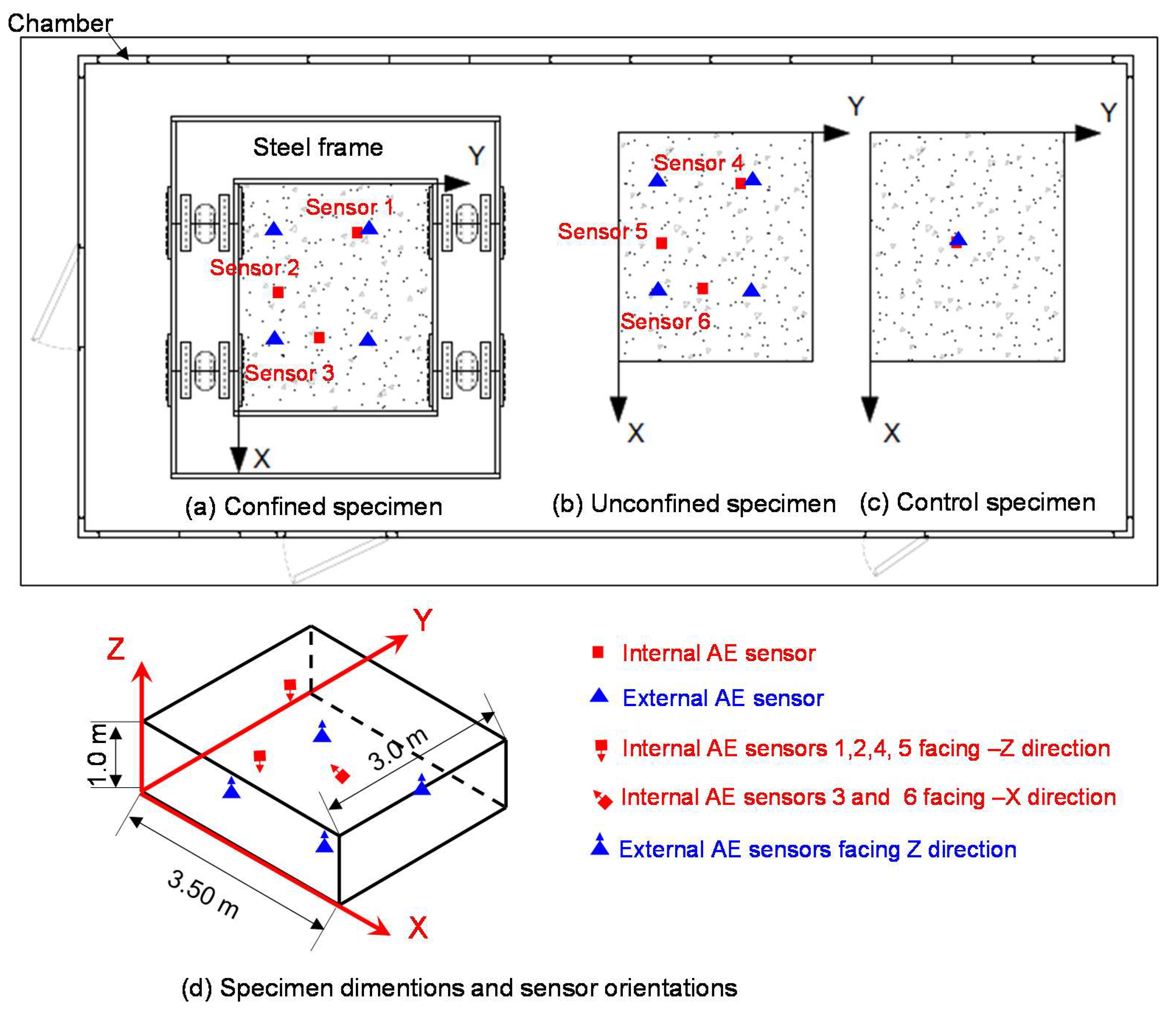
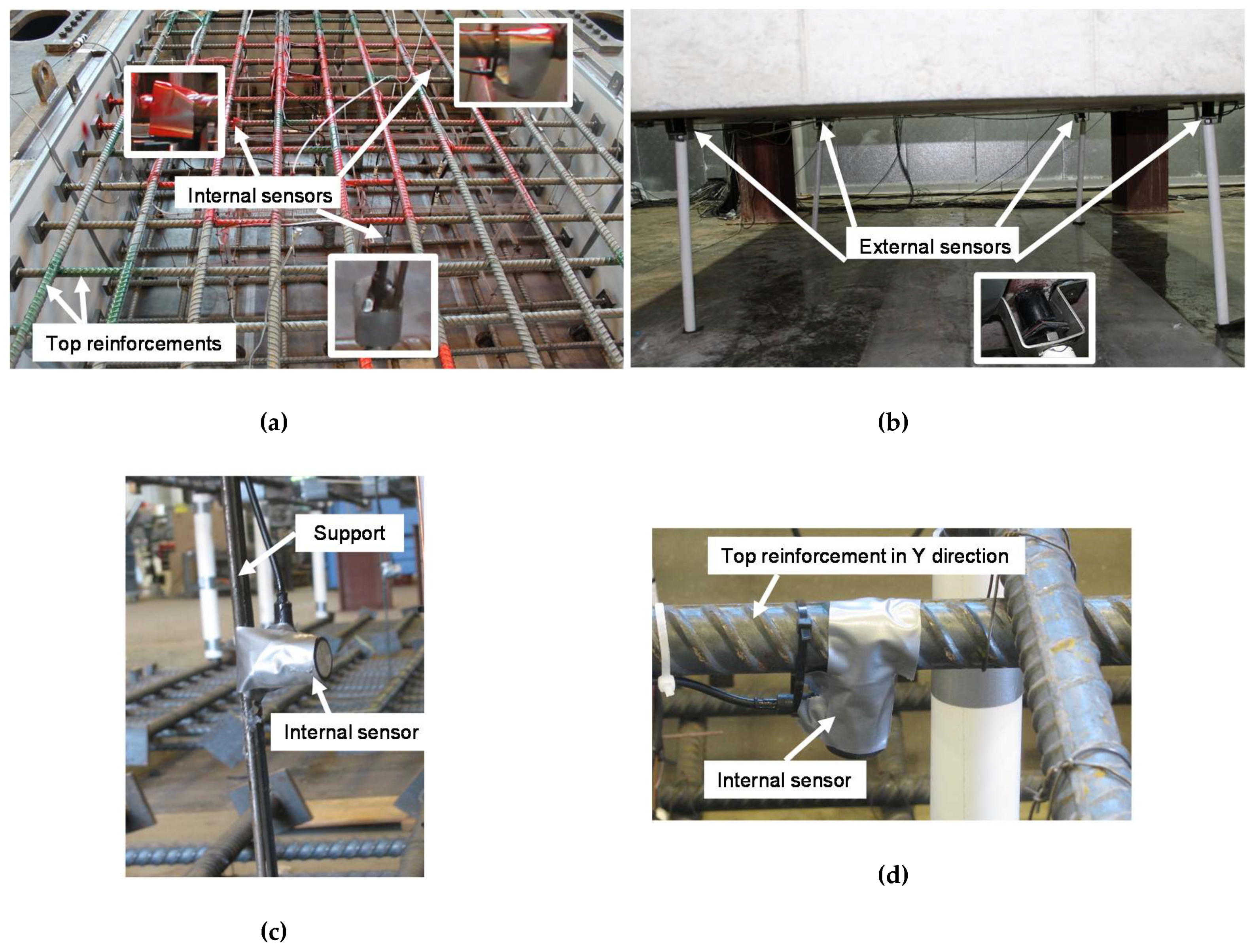
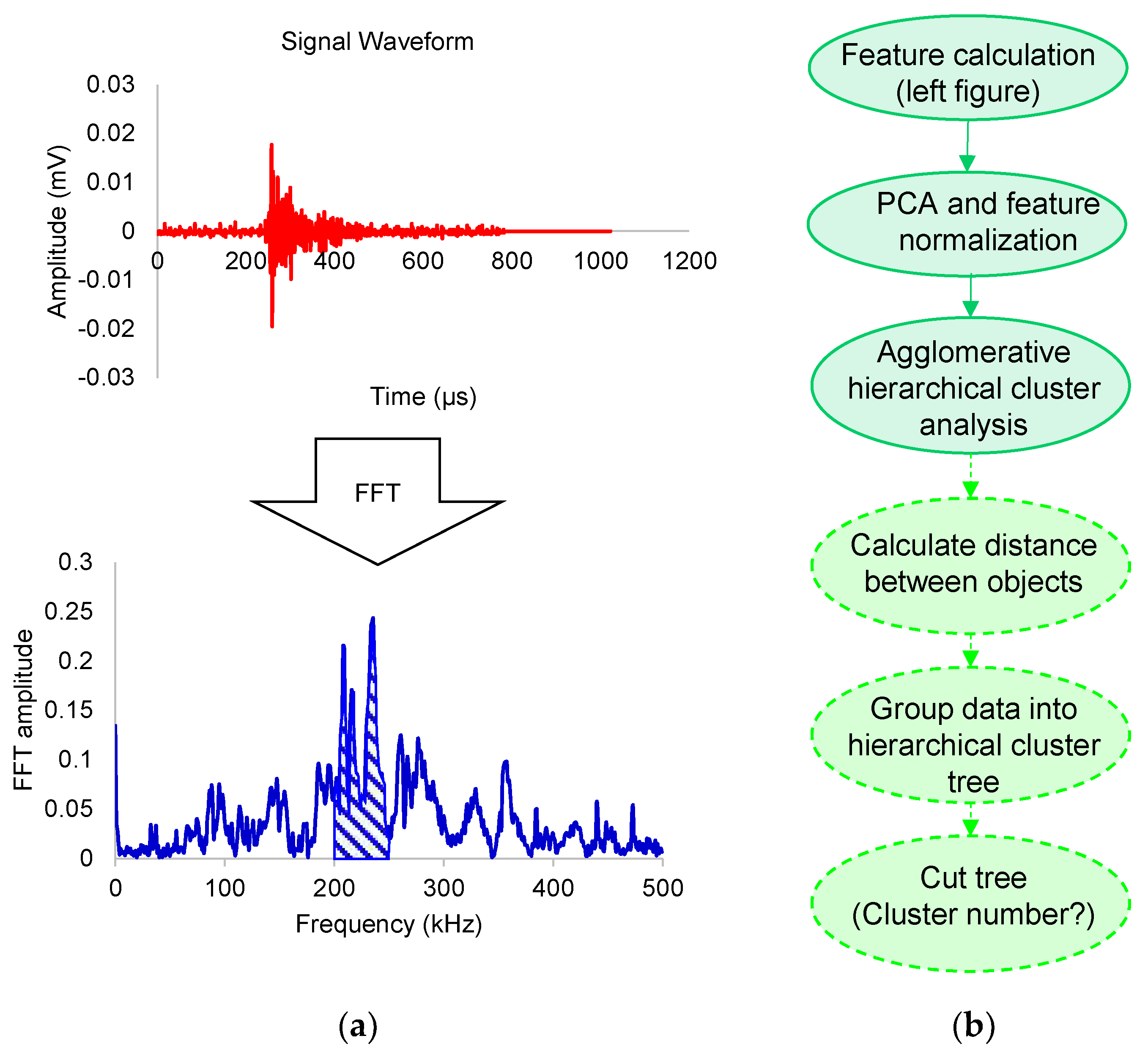
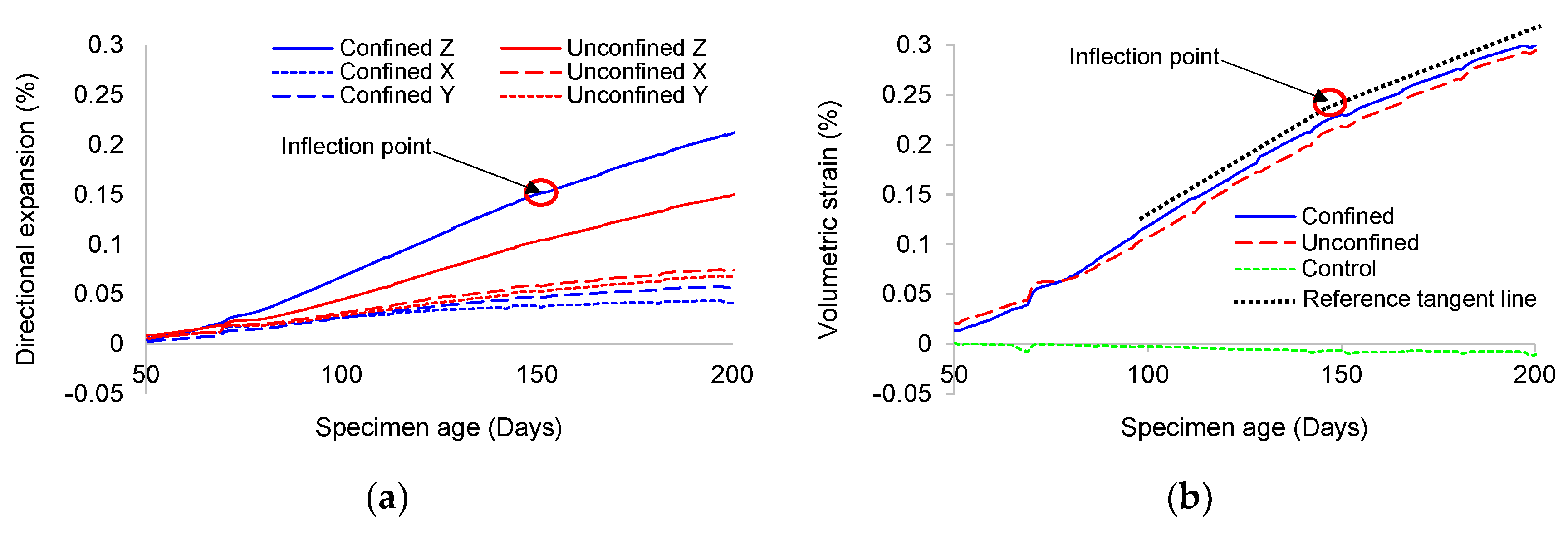
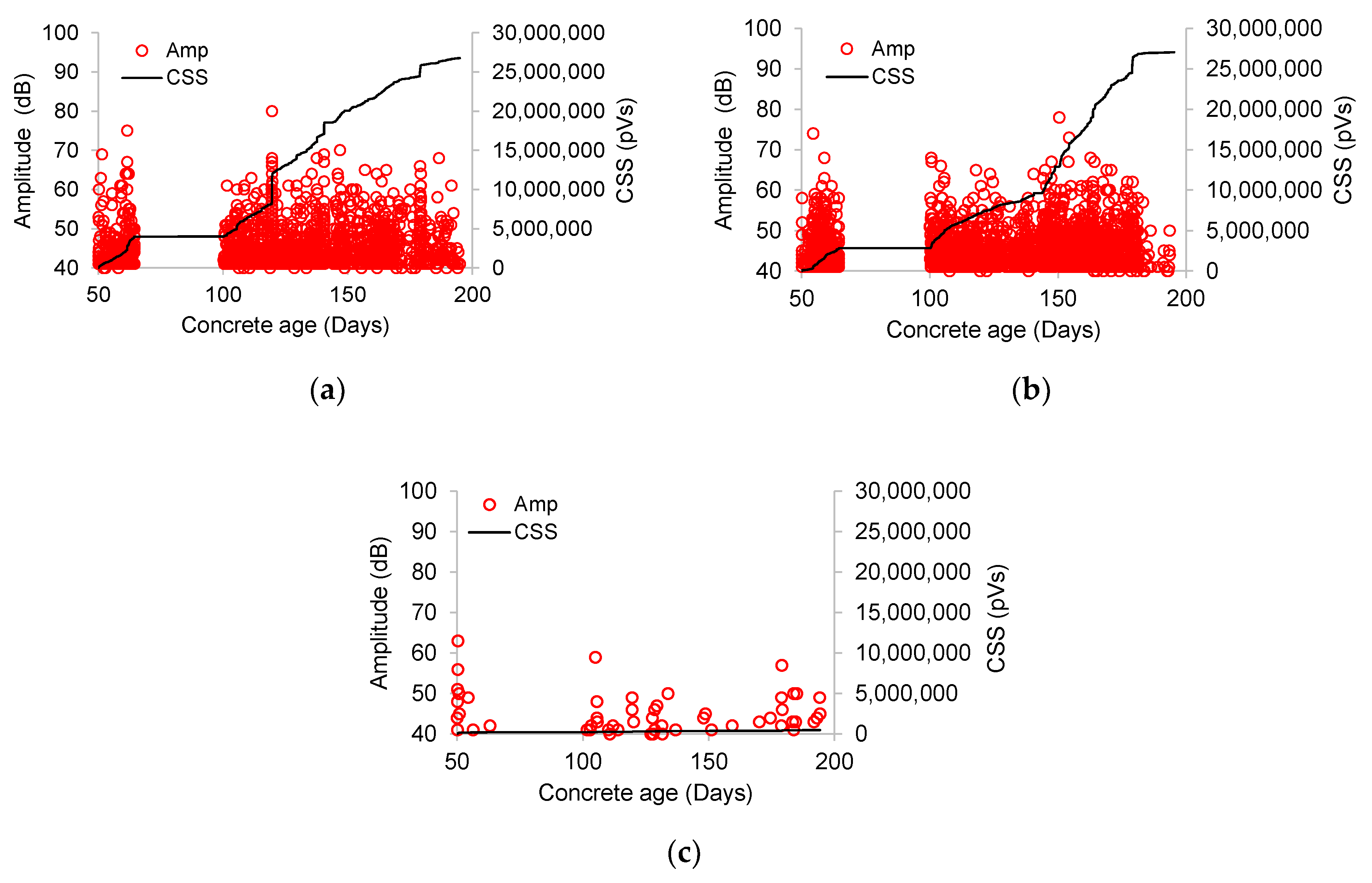
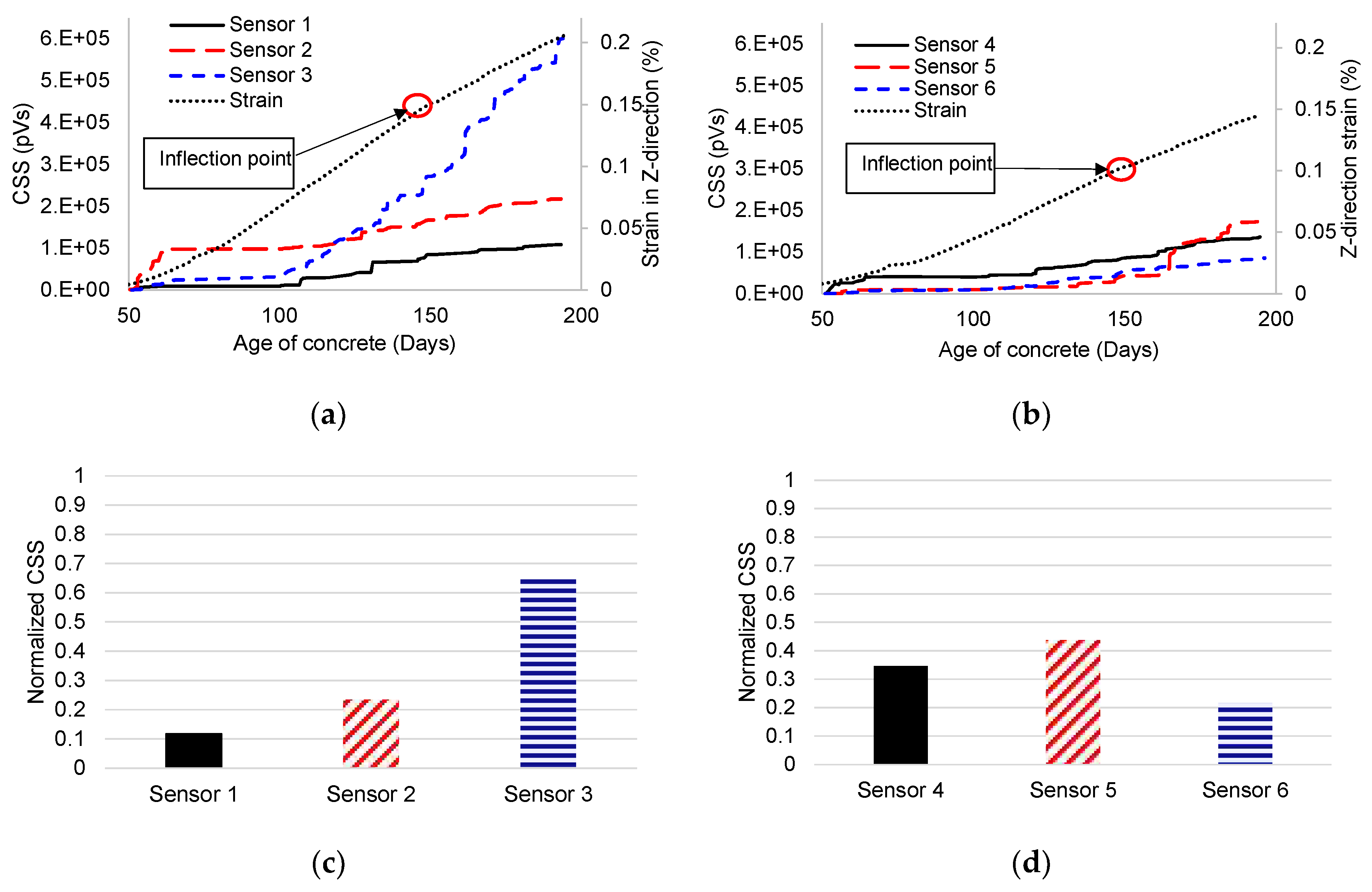
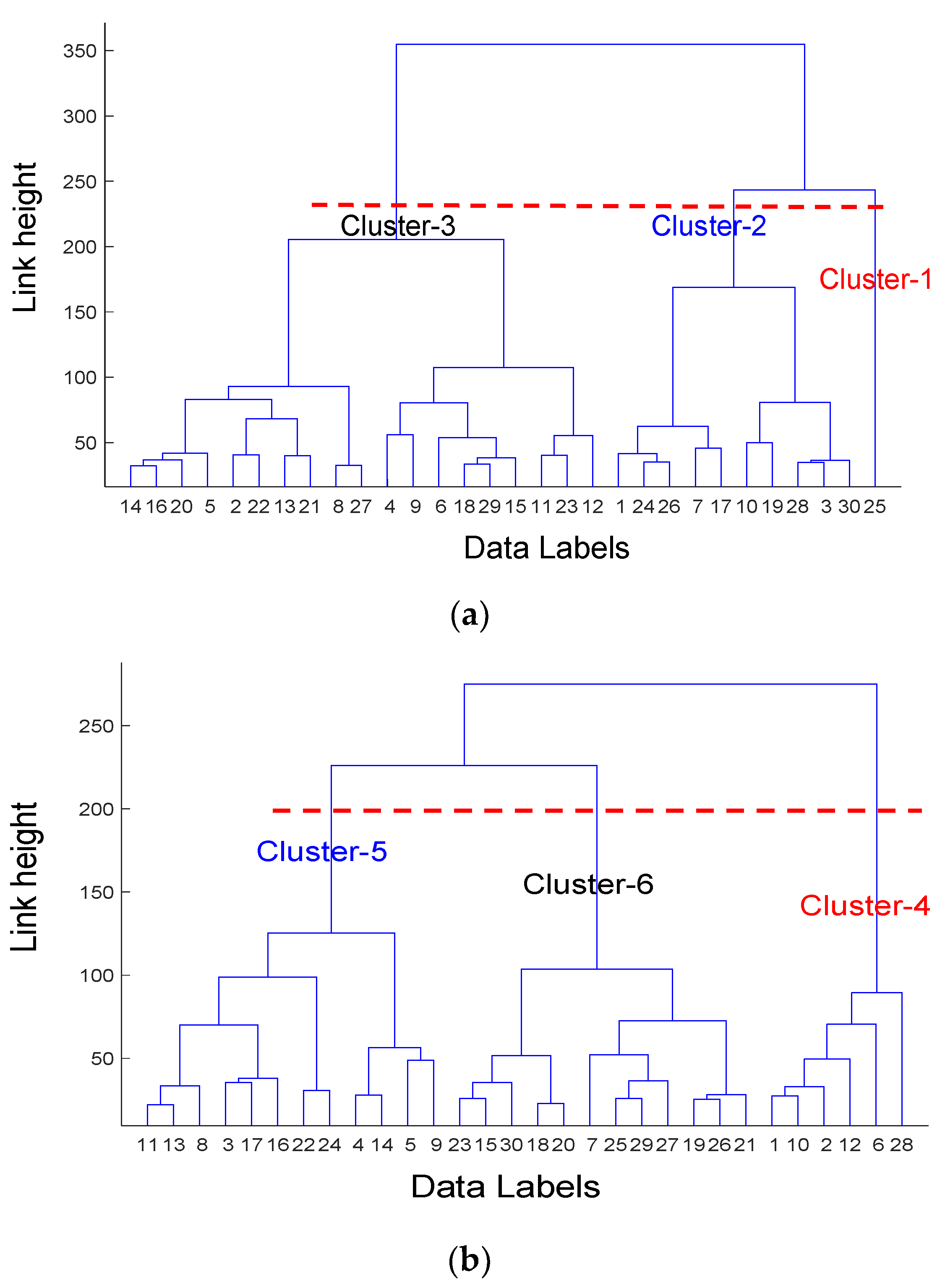
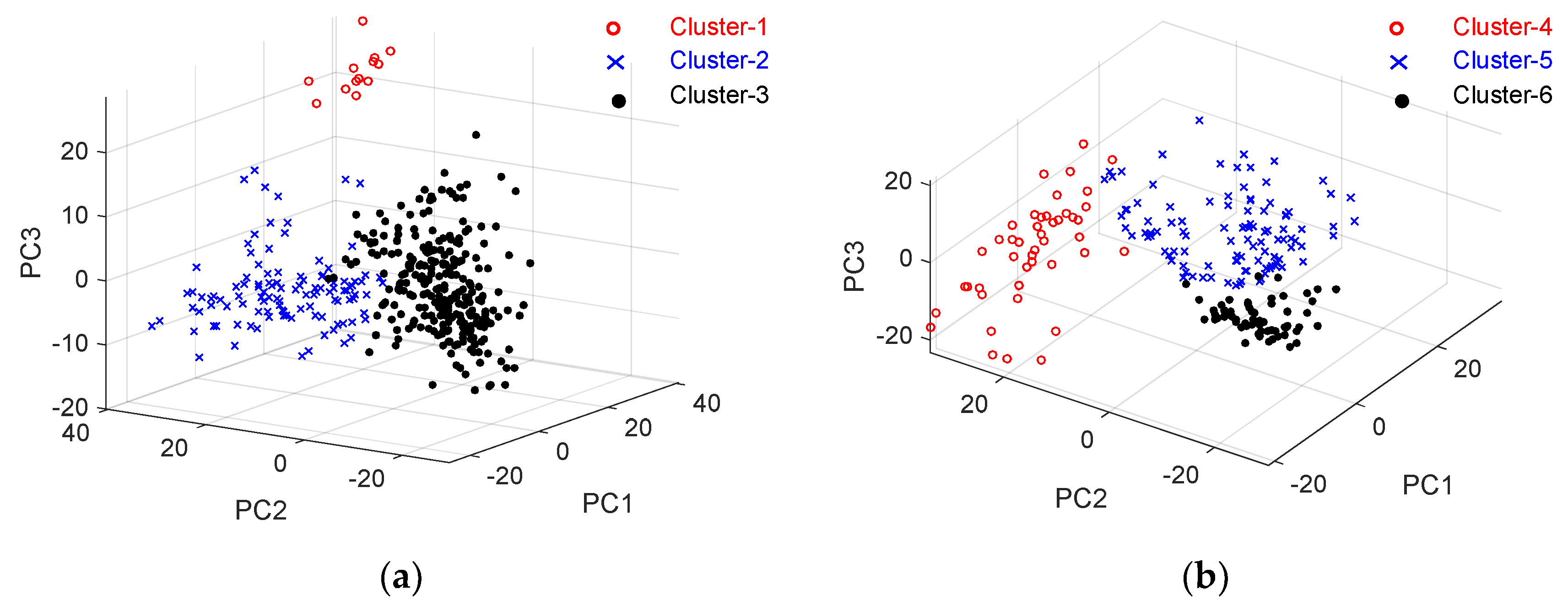
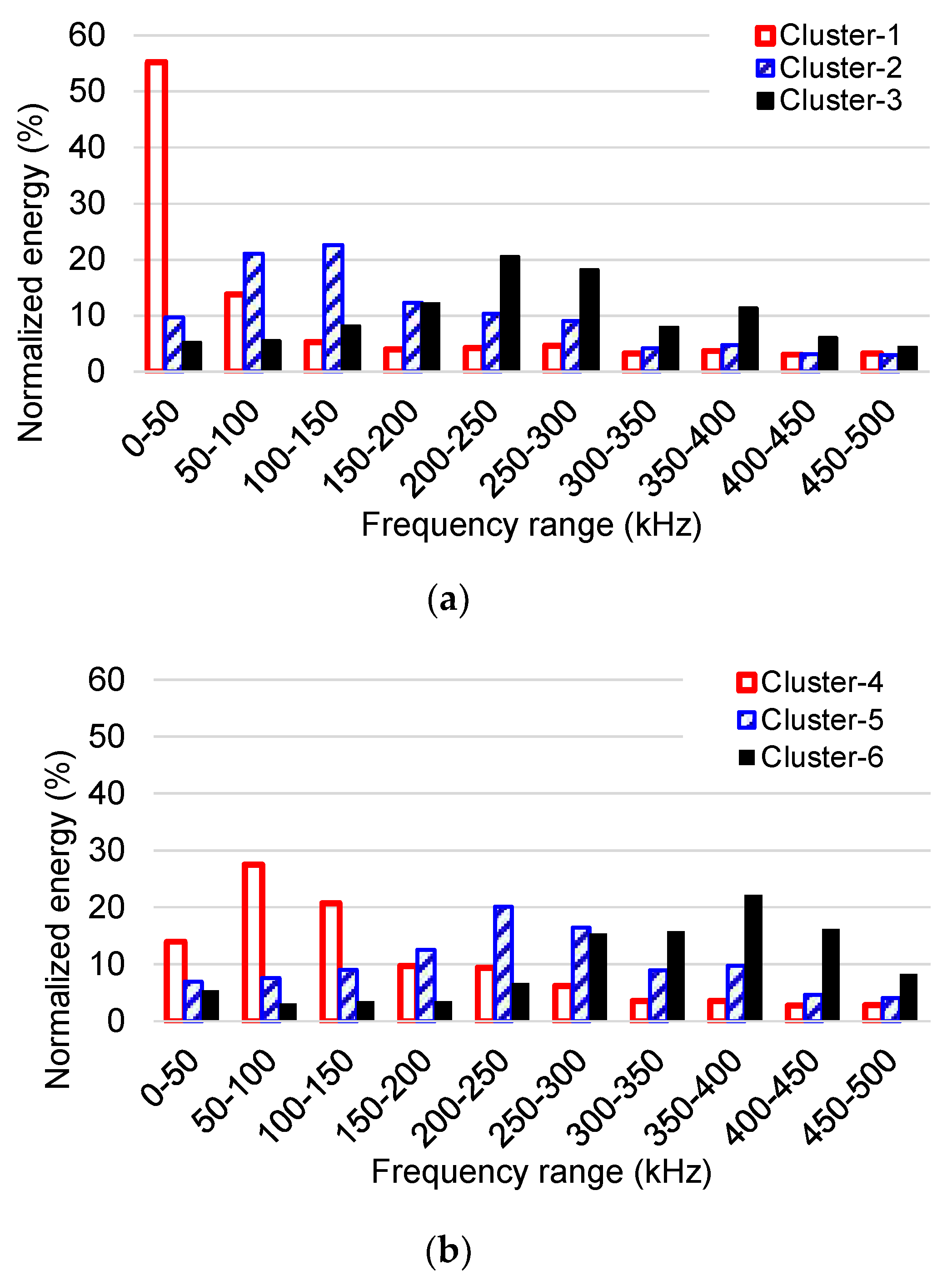

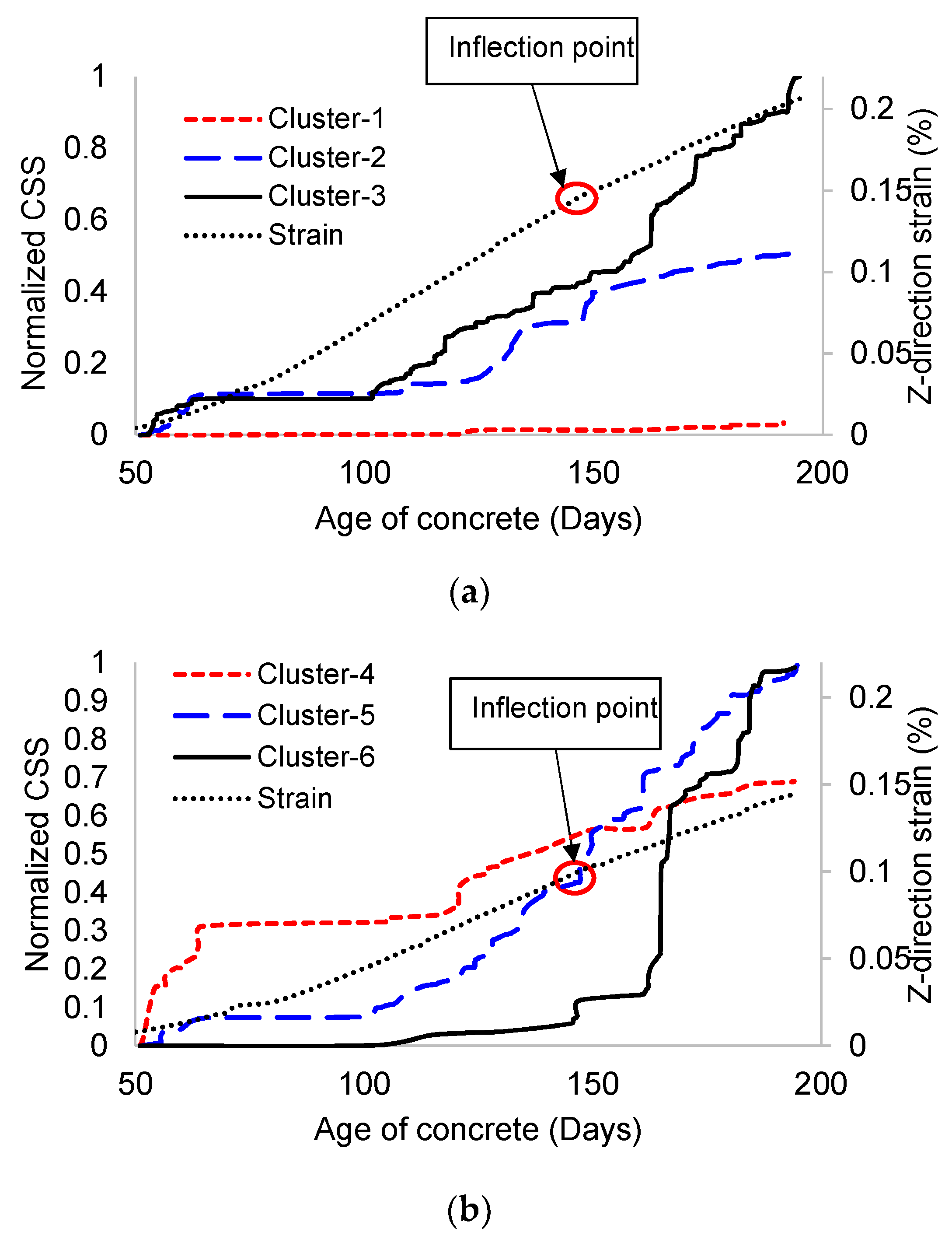

| External Sensor | Internal Sensor | ||
|---|---|---|---|
| Amplitude (dB) | Duration (µs) | Amplitude (dB) | Duration (µs) |
| 41–43 | 400< | 32–35 | 155< |
| 44–45 | 500< | 36–42 | 260< |
| 46–47 | 600< | 43–100 | 330< |
| 48–49 | 650< | - | - |
| 50–53 | 820< | - | - |
| 54–56 | 940< | - | - |
| 57–65 | 1080< | - | - |
| 66–100 | 1400< | - | - |
| Sensor No. | X (m) | Y (m) | Z (m) | |
|---|---|---|---|---|
| Sensor 1 | 1.08 | 1.91 | 0.86 | (0,0,−1) |
| Sensor 2 | 1.85 | 0.78 | 0.86 | (0,0,−1) |
| Sensor 3 | 2.34 | 1.46 | 0.5 | (−1,0,0) |
| Sensor 4 | 1.1 | 1.59 | 0.86 | (0,0,−1) |
| Sensor 5 | 1.83 | 0.88 | 0.86 | (0,0,−1) |
| Sensor 6 | 2.36 | 1.59 | 0.5 | (−1,0,0) |
© 2018 by the authors. Licensee MDPI, Basel, Switzerland. This article is an open access article distributed under the terms and conditions of the Creative Commons Attribution (CC BY) license (http://creativecommons.org/licenses/by/4.0/).
Share and Cite
Soltangharaei, V.; Anay, R.; Hayes, N.W.; Assi, L.; Le Pape, Y.; Ma, Z.J.; Ziehl, P. Damage Mechanism Evaluation of Large-Scale Concrete Structures Affected by Alkali-Silica Reaction Using Acoustic Emission. Appl. Sci. 2018, 8, 2148. https://doi.org/10.3390/app8112148
Soltangharaei V, Anay R, Hayes NW, Assi L, Le Pape Y, Ma ZJ, Ziehl P. Damage Mechanism Evaluation of Large-Scale Concrete Structures Affected by Alkali-Silica Reaction Using Acoustic Emission. Applied Sciences. 2018; 8(11):2148. https://doi.org/10.3390/app8112148
Chicago/Turabian StyleSoltangharaei, Vafa, Rafal Anay, Nolan W. Hayes, Lateef Assi, Yann Le Pape, Zhongguo John Ma, and Paul Ziehl. 2018. "Damage Mechanism Evaluation of Large-Scale Concrete Structures Affected by Alkali-Silica Reaction Using Acoustic Emission" Applied Sciences 8, no. 11: 2148. https://doi.org/10.3390/app8112148





